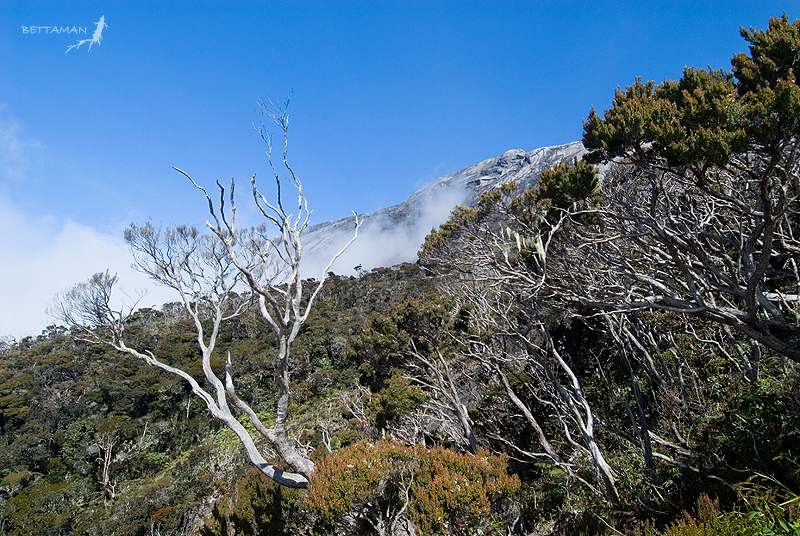Elevation increases in moth assemblages over 42 years on a tropical mountain
PNAS (2009) 105: 1479-1483. Full Text: PDF (Size: 870K)
PNAS (2009) 105: 1479-1483. Full Text: PDF (Size: 870K)
I-Ching Chena, Hau-Jie Shiub, Suzan Benedickc, Jeremy D. Hollowayd, Vun Khen Cheye, Henry S. Barlowf, Jane K. Hilla and Chris D. Thomasa
a Department of Biology, University of York, P.O. Box 373, York YO10 5YW, United Kingdom; b Graduate Institute of Environmental Sciences and Ecology, National University of Tainan, 33 Su-Lin Street, Section 2, Tainan 700, Taiwan; c S chool of Sustainable Agriculture, Universiti Malaysia Sabah, Aras 2, Blok B, Bangunan Sekolah Sains and Teknologi, Locked Bag 2073, 88999 Kota Kinabalu, Sabah, Malaysia; d Department of Entomology, The Natural History Museum, Cromwell Road, London SW7 5BD, United Kingdom; e Entomology Section, Forest Research Centre of Sabah, Sepilok, P.O. Box 1407, Postcode 90715, Sandakan, Malaysia; and f P.O. Box 10139, Postcode 50704, Kuala Lumpur, Malaysia
簡介
簡介
以長時間的尺度來討論生物與環境間的議題,在國外有不少的文獻可供參考,這類研究除了對於標的生物(target species)進行族群動態的監測之外,其統計數據亦可用於瞭解其組成結構的環境因子是否有所改變,而大部分研究最關切的議題即是全球暖化。以2007年聯合國跨政府氣後變遷小組 IPCC (Intergovernmental Panel on Climate Change) 所出版的統計數據,顯示從1970年至2004年共有28,586件生物波動觀察與佐證,其中絕多數為溫帶地區所作的研究,此外熱帶地區僅有7件以鳥類、爬蟲類、兩生類等脊椎動物所進行的調查,而其中並沒有在無脊椎或昆蟲相上的數據。
要了解長期的物種或地域性的群聚波動,即需要不同年份與季節的數據資料、不因時空背景而淘汰且重覆性高的研究方法,甚至是經費上的有力支援。在台灣以長期動態為研究目標的計畫早期大多為植被相監測,例如南仁山、福山植物園與楠溪內所設的永久樣區,以最早1989年南仁山所設的三個樣區來說,至今近20年才開始進行第一次複查,而動物相與昆蟲相大致僅有福山植物園內已完成或進行中的大鱗翅群調查計畫,可見台灣的長期生物相調查仍處於初始資料的累積。
2008年由赴英國約克大學(York University)攻讀學位的台灣籍研究生陳一菁、台南大學環境生態研究所許皓捷博士以及他國際研究員等人提出了婆羅洲京那巴魯山區(Mt. Kinabalu)蛾類群落往較高海拔移動的證據。此研究比較了1965年與2007年兩次在此山區採集的鱗翅目樣本,經統計得到102種尺蛾科分類群之海拔梯度分布在42年間上升了67公尺 。關於這樣的結果,研究群認為除了可能是氣候變遷所造成的直接影響,也可能導因於尺蛾的寄主植物受環境因子波動的間接結果。
副熱帶地區的昆蟲相是否受到全球氣候變遷而有所影像? 副熱帶高山帶是否可作為氣候暖化時,溫帶型物種或是地域性特有種的庇護所? 這兩個議題在介於熱帶與副熱帶的台灣都可以籌議長期的生物相調查。
相關報導與參考:
ABSTRACT
Physiological research suggests that tropical insects are particularly sensitive to temperature, but information on their responses toclimate change has been lacking—even though the majority of all terrestrial species are insects and their diversity is concentrated in the tropics. Here, we provide evidence that tropical insect specieshave already undertaken altitude increases, confirming the global reach of climate change impacts on biodiversity. In 2007, we repeated a historical altitudinal transect, originally carried out in 1965 on Mount Kinabalu in Borneo, sampling 6 moth assemblagesbetween 1,885 and 3,675 m elevation. We estimate that the average altitudes of individuals of 102 montane moth species, inthe family Geometridae, increased by a mean of 67 m over the 42 years. Our findings indicate that tropical species are likely to be as sensitive as temperate species to climate warming, and we urge ecologists to seek other historic tropical samples to carry out similar repeat surveys. These observed changes, in combination with the high diversity and thermal sensitivity of insects, suggest that large numbers of tropical insect species could be affected by climate warming. As the highest mountain in one of the most biodiverse regions of the world, Mount Kinabalu is a globally important refuge for terrestrial species that become restricted to high altitudes by climate warming.


沒有留言:
張貼留言